Urban Shrinkage in the Qinling–Daba Mountains: Spatiotemporal Patterns and Influencing Factors
Abstract
1. Introduction
2. Materials and Methods
2.1. Study Area
2.2. Data Sources
- (1)
- Administrative Boundary Data: the administrative boundary data for county-level cities in the Qinling–Daba Mountains were sourced from the National Platform for Common GeoSpatial Information Services.
- (2)
- Statistical Information: The majority of the data on natural, demographic, economic, and social elements used in this study were derived from the Statistical Bulletins and Yearbooks of provincial and prefecture-level municipal areas, as well as from various population and economic censuses. Missing data were incorporated through interpolation techniques.
- (3)
- Digital Elevation Model (DEM): the Digital Elevation Model was used to calculate the average elevation and topographic relief, while also assisting in the delineation of the study area. The Geospatial Data Cloud served as the source for these data.
- (4)
- Point of Interest (POI) Data: POI data, in the form of spatial features with geographic identifiers, encompass information such as name, category, latitude, and longitude. These data were sourced from online map service providers, including Amap. Analyzing the spatial distribution of various POIs enables the elucidation of socio-economic indicators, such as investments in science and education, the level of medical services, and environmental livability within a specific region, thereby enhancing and supplementing existing statistical data.
- (5)
- Nighttime Light Data: The calibration of Defense Meteorological Satellite Program Operational Line Scanning System (DMSP-OLS) data and Suomi National Polar-orbiting Partnership’s Visible Infrared Imaging Radiometer Suite (SNPP-VIIRS) data to generate DMSP-OLS-like data effectively addresses the incompatibility between these two satellite datasets [48]. In this study, the calibrated DMSP-OLS-like data were utilized to extract nighttime light data for the Qinling–Daba Mountains, aiding in the identification of urban shrinkage.
- (6)
- Road Traffic Data: Vector data representing the road infrastructure within the counties of the Qinling–Daba Mountains, along with the distances from these counties to provincial and prefecture-level cities, were obtained through data extraction from Amap services.
2.3. Research Framework and Methods
2.3.1. Research Framework
2.3.2. Methods
- (1)
- Measurement of urban shrinkage
- (1)
- Growth rate of permanent resident population
- (2)
- Growth Rate of Nighttime Light
- (2)
- Measurements of the influencing factors
- (1)
- Construction of an indicator system
- (2)
- Screening of influencing factors
- (3)
- Analysis of influencing factors
3. Results
3.1. The Spatial and Temporal Characteristics of the Evolution of Urban Shrinkage in the Qinling–Daba Mountains
3.2. Influencing Factors of Urban Shrinkage in the Qinling–Daba Mountains
3.2.1. Analysis of the Temporal Evolution of Influencing Factors
3.2.2. Analysis of the Spatial Heterogeneity of Influencing Factors
4. Discussion
4.1. The Paradox of Population Loss and Spatial Expansion
4.2. The Driving Mechanisms of Urban Shrinkage in Underdeveloped Regions
4.2.1. The Population Dimension: The Bidirectional Feedback Between the Working-Age Population and Educational Resources
4.2.2. The Economic Dimension: The Negative Cycle of Industrial Hollowing Out and Declining Income and Employment
4.2.3. The Social Dimension: A Staged Mismatch Between Inefficient Spatial Expansion and the Provision of Supporting Functions
4.3. Adaptation Strategies for Shrinkage in Underdeveloped Regions
- (1)
- Deepen the linkage between education and industry to address the structural talent drain
- (2)
- Implement a “smart response” strategy based on the spatial pattern of a city to improve supply efficiency and matching
- (3)
- Adapt ecological compensation mechanisms to address development challenges arising from population loss and spatial expansion
4.4. Innovation and Limitations
5. Conclusions
- (1)
- There was evident spatial and temporal heterogeneity in the percentage and distribution of urban shrinkage patterns in the Qinling–Daba Mountains. In this study, county-level cities in the region were classified into four urban spatial patterns: expansion–growth, intensive growth, expansion–shrinkage, and intensive shrinkage. From 2005 to 2010, expansion–growth cities accounted for the largest percentage and were primarily distributed in the western and central parts of the Qinling–Daba Mountains. During 2010–2015, intensive growth cities became the dominant category, predominantly located in the northern–central part of the study area. Between 2015 and 2022, the percentage of expansion–shrinkage cities increased significantly, ultimately forming a large expansion–shrinkage zone, while a small number of expansion–growth cities remained interspersed throughout the region. These expansion–growth cities were mainly distributed in specific urban areas and their surrounding areas.
- (2)
- The influence of various factors on urban shrinkage in the Qinling–Daba Mountains exhibited significant temporal variations. The primary determinants of urban shrinkage in this region were the number of students enrolled in general secondary schools (X5), per capita disposable income of urban residents (X7), and number of commercial and residential service facilities (X12). Collectively, these factors exerted an overall positive impact and mitigated urban shrinkage. However, their dominant roles varied over time. In 2005 and 2010, the primary driver was the number of commercial and residential service facilities (X12). In contrast, in 2015, 2020, and 2022, the predominant factors shifted to the number of students enrolled in general secondary schools (X5) and per capita disposable income (X7). While other influencing factors continued to affect urban shrinkage, their impact generally weakened over time, and their directional influence changed.
- (3)
- The spatial effects of influencing factors on urban shrinkage in the Qinling–Daba Mountains exhibited significant heterogeneity. Throughout the entire study period, the number of students enrolled in general secondary schools (X5) exerted a significantly stronger influence in the western part of the Qinling–Daba Mountains than in the eastern region. In contrast, the number of commercial residential service facilities (X12) showed the opposite trend. Additionally, the per capita disposable income of urban residents demonstrated a pattern of higher values in the eastern and western regions, with a relative decline in the central part of the region. With the exception of the birth rate (X3), all other influencing factors exerted a stronger effect in the eastern region than in the western region.
Author Contributions
Funding
Institutional Review Board Statement
Informed Consent Statement
Data Availability Statement
Conflicts of Interest
Abbreviations
| GTWR | Geographically and Temporally Weighted Regression |
| POI | Point of Interest |
References
- Hospers, G.J. Policy Responses to Urban Shrinkage: From Growth Thinking to Civic Engagement. Eur. Plan. Stud. 2014, 22, 1507–1523. [Google Scholar] [CrossRef]
- Martinez-Fernandez, C.; Weyman, T.; Fol, S.; Audirac, I.; Cunningham-Sabot, E.; Wiechmann, T.; Yahagi, H. Shrinking cities in Australia, Japan, Europe and the USA: From a global process to local policy responses. Prog. Plan. 2016, 105, 1–48. [Google Scholar] [CrossRef]
- Eraydin, A.; Özatağan, G. Pathways to a resilient future: A review of policy agendas and governance practices in shrinking cities. Cities 2021, 115, 103226. [Google Scholar] [CrossRef]
- Batunova, E.; Gunko, M. Urban shrinkage: An unspoken challenge of spatial planning in Russian small and medium-sized cities. Eur. Plan. Stud. 2018, 26, 1580–1597. [Google Scholar] [CrossRef]
- Zhang, W.; Shan, F.F.; Zheng, C.G.; Hu, R. Multi-dimensional Identification and Driving Mechanism Analysis of Shrinking City in China. Urban Dev. Stud. 2019, 26, 32–40. [Google Scholar]
- Zingale, N.C.; Riemann, D. Coping with shrinkage in Germany and the United States: A cross-cultural comparative approach toward sustainable cities. Urban Des. Int. 2012, 18, 90–98. [Google Scholar] [CrossRef]
- Han, Z.X.; Xie, W.; Yu, H.J.; Xie, H.Y.; Li, Y.; Wang, Y.T. Rethinking industrial land-use in American rust cities towards sustainability based on a block-level model. J. Environ. Manag. 2024, 352, 120067. [Google Scholar] [CrossRef]
- Rocak, M.; Hospers, G.-J.; Reverda, N. Searching for Social Sustainability: The Case of the Shrinking City of Heerlen, The Netherlands. Sustainability 2016, 8, 382. [Google Scholar] [CrossRef]
- Peng, W.; Fan, Z.; Duan, J.; Gao, W.; Wang, R.; Liu, N.; Li, Y.; Hua, S. Assessment of interactions between influencing factors on city shrinkage based on geographical detector: A case study in Kitakyushu, Japan. Cities 2022, 131, 103958. [Google Scholar] [CrossRef]
- Jeon, Y.; Kim, S. Housing abandonment and socio-spatial inequalities: Experience from a shrinking inner-city area of Incheon, South Korea. Hous. Stud. 2023, 39, 2901–2918. [Google Scholar] [CrossRef]
- Yan, G.H.; Chen, X.; Zhang, Y. Shrinking Cities Distribution Pattern and Influencing Factors in Northeast China Based on Random Forest Model. Geogr. Sci. 2021, 41, 880–889. [Google Scholar] [CrossRef]
- Gao, S.Q.; Long, Y. Distinguishing And Planning Shrinking Cities In Northeast China. Planners 2016, 33, 26–32. [Google Scholar]
- Ivanov, B. Narratives of Crisis: How Framing Urban Shrinkage and Depopulation Shapes Policy and Planning Responses in Spain, Germany and The Netherlands. Sustainability 2021, 13, 11045. [Google Scholar] [CrossRef]
- Schilling, J.; Logan, J. Greening the Rust Belt A Green Infrastructure Model for Right Sizing America’s Shrinking Cities. J. Am. Plan. Assoc. 2008, 74, 451–466. [Google Scholar] [CrossRef]
- Wolff, M.; Wiechmann, T. Urban growth and decline: Europe’s shrinking cities in a comparative perspective 1990–2010. Eur. Urban Reg. Stud. 2018, 25, 122–139. [Google Scholar] [CrossRef]
- Sun, P.J.; Wang, K.W. Identification and stage division of urban shrinkage in the three provinces of Northeast China. Acta Geogr. Sin. 2021, 76, 1366–1379. [Google Scholar]
- Szymczyk, E.; Bukowski, M.; Kenworthy, J.R. Understanding the Relationship between Urban Form and Urban Shrinkage among Medium-Sized Cities in Poland and Its Implications for Sustainability. Sustainability 2024, 16, 7030. [Google Scholar] [CrossRef]
- Eva, M.; Cehan, A.; Lazar, A. Patterns of Urban Shrinkage: A Systematic Analysis of Romanian Cities (1992–2020). Sustainability 2021, 13, 7514. [Google Scholar] [CrossRef]
- Ungureanu, T.; Șoimoșan, T.M. An Integrated Analysis of the Urban Form of Residential Areas in Romania. Buildings 2023, 13, 2525. [Google Scholar] [CrossRef]
- Liu, F.B.; Zhu, X.G.; Chen, J.; Sun, J.; Lin, X. The Research on the Quantitative Identification and Cause Analysis of Urban Shrinkage from Different Dimensions and Scales: A Case Study of Northeast China during Transformation Period. Mod. Urban Res. 2018, 7, 37–46. [Google Scholar]
- Wichowska, A. Economic Aspects of Shrinking Cities in Poland in the Context of Regional Sustainable Development. Sustainability 2021, 13, 3104. [Google Scholar] [CrossRef]
- Liu, Z.; Qi, W.; Qi, H.G.; Liu, S.H. Spatial distribution of population decline areas in China and underlying causes from a multi-periodical perspective. Prog. Geogr. 2021, 40, 357–369. [Google Scholar] [CrossRef]
- Djurkin, D.; Antic, M.; Djordjevic, D.Z. Demographic Aspects of Urban Shrinkage in Serbia: Trajectory, Variety, and Drivers of Shrinking Cities. Sustainability 2023, 15, 15961. [Google Scholar] [CrossRef]
- Zheng, H.; Zhang, R.S. Identification of shrinkage patterns in Japan’s four major metropolitan areas based on nighttime light and population data. Int. J. Appl. Earth Obs. Geoinf. 2025, 136, 104391. [Google Scholar] [CrossRef]
- Meng, X.F.; Ma, S.; Xiang, W.Y.; Kan, C.C.; WU, K.; Long, Y. Classification of shrinking cities in China using Baidu big data. Acta Geogr. Sin. 2021, 76, 2477–2488. [Google Scholar]
- Zhang, S.; Wang, C.X.; Wang, J.; Yao, S.M.; Zhang, F.; Yin, G.W.; Xu, X.Y. On the comprehensive measurement of urban shrink in China and its spatio-temporal differentiation. Chin. J. Popul. Resour. Environ. 2024, 30, 72–82. [Google Scholar]
- He, X.J.; Guan, D.J.; Zhou, L.L.; Zhang, Y.X.; Gao, W.J.; Sun, L.L.; Huang, D.A.; Li, Z.H.; Cao, J.M.; Su, X.Y. Quantifying spatiotemporal patterns and influencing factors of urban shrinkage in China within a multidimensional framework:A case study of the Yangtze River Economic Belt. Sustain. Cities Soc. 2023, 91, 104452. [Google Scholar] [CrossRef]
- Wiechmann, T.; Pallagst, K.M. Urban shrinkage in Germany and the USA: A Comparison of Transformation Patterns and Local Strategies. Int. J. Urban Reg. Res. 2012, 36, 261–280. [Google Scholar] [CrossRef]
- Zhang, M.D.; Xiao, H. Spatial pattern characteristics and mechanism of urban contraction in Northeast China. Urban Probl. 2020, 1, 33–42. [Google Scholar]
- Wu, K.; Long, Y.; Yang, Y. Uran Shinkage in the Beijing-Tianjin-Heibei Region and Yangtze River Delta:Pattern, Trajectory and Factors. Mod. Urban Res. 2015, 30, 26–35. [Google Scholar]
- Wang, X.; Li, Z.; Feng, Z. Classification of Shrinking Cities in China Based on Self-Organizing Feature Map. Land 2022, 11, 1525. [Google Scholar] [CrossRef]
- Wiechmann, T.; Bontje, M. Responding to Tough Times: Policy and Planning Strategies in Shrinking Cities. Eur. Plan. Stud. 2013, 23, 1–11. [Google Scholar] [CrossRef]
- Segers, T.; Devisch, O.; Herssens, J.; Vanrie, J. Conceptualizing demographic shrinkage in a growing region—Creating opportunities for spatial practice. Landsc. Urban Plan. 2020, 195, 103711. [Google Scholar] [CrossRef]
- Bernt, M. The Limits of Shrinkage: Conceptual Pitfalls and Alternatives in the Discussion of Urban Population Loss. Int. J. Urban Reg. Res. 2015, 40, 441–450. [Google Scholar] [CrossRef]
- Schackmar, J.; Fleschurz, R.; Pallagst, K. The Role of Substitute Industries for Revitalizing Shrinking Cities. Sustainability 2021, 13, 9250. [Google Scholar] [CrossRef]
- Jang, G.; Kim, S. Are decline-oriented strategies thermally sustainable in shrinking cities? Urban Clim. 2021, 39, 100924. [Google Scholar] [CrossRef]
- Döringer, S.; Uchiyama, Y.; Penker, M.; Kohsaka, R. A meta-analysis of shrinking cities in Europe and Japan. Towards an integrative research agenda. Eur. Plan. Stud. 2019, 28, 1693–1712. [Google Scholar] [CrossRef]
- Iwasaki, Y. Shrinkage of regional cities in Japan: Analysis of changes in densely inhabited districts. Cities 2021, 113, 103168. [Google Scholar] [CrossRef]
- Deng, P.Y.; Liu, Y.H. Spatial Pattern and Influence Factors Analysis of Population Shrinkage in County Unit in China. Mod. Urban Res. 2018, 3, 31–38. [Google Scholar]
- Zhang, X.L.; Zhou, S.M. Evolution of Regional Population Decline and Its Driving Factors at the County Level in China. Econ. Geogr. 2023, 43, 42–51+98. [Google Scholar] [CrossRef]
- Martinez-Fernandez, C.; Audirac, I.; Fol, S.; Cunningham-Sabot, E. Shrinking Cities: Urban Challenges of Globalization. Int. J. Urban Reg. Res. 2012, 36, 213–225. [Google Scholar] [CrossRef]
- Meng, F.X.; Wang, D.Y.; Li, H. Analysis on Driving Forces of Urban Shrinkage in Old Industrial Cities of Northeast China. Mod. Urban Res. 2020, 3, 25–32. [Google Scholar]
- Jiang, Y.H.; Chen, Z.J.; Sun, P.J. Urban Shrinkage and Urban Vitality Correlation Research in the Three Northeastern Provinces of China. Int. J. Environ. Res. Public Health 2022, 19, 10650. [Google Scholar] [CrossRef]
- Du, Z.W.; Li, X. Growth or shrinkage: New phenomena of regional development in the rapidly-urbanising Pearl River Delta. Acta Geogr. Sin. 2017, 72, 1800–1811. [Google Scholar]
- Luo, F.Z.; Zhou, T.T.; Liu, G.C. Comprehensive Measurement and Type Identification of Urban Shrinkage at County-Level: A Case Study of Shaanxi, A Cluster of Small and Medium-Sized Cities. Mod. Urban Res. 2022, 10, 52–58. [Google Scholar]
- Xiao, J.; Qiao, J.; Han, D.; Liu, Y.; Pan, T. Spatial Coupling Relationship and Driving Mechanism of Population and Economy in Rural Areas in Qinling-Daba Mountains, China. Chin. Geogr. Sci. 2023, 33, 779–795. [Google Scholar] [CrossRef]
- Yang, W.L.; Tan, J.B.; Fan, B.; Wang, Z.L.; Yang, Y.H.; Liu, H. Spatial-Temporal Coupling Coordination Relationship Between Industrial Ecosystem Adaptability and Resource Environmental Bearing Capacity in County-level Mountain Region—A Case Study of 81Districts and Counties in the Qinba Mountain Region. Res. Soil Water Conserv. 2022, 29, 363–374. [Google Scholar]
- Wu, Y.; Shi, K.; Chen, Z.; Liu, S.; Chang, Z. Developing Improved Time-Series DMSP-OLS-Like Data (19922019) in China by Integrating DMSP-OLS and SNPP-VIIRS. IEEE Trans. Geosci. Remote Sens. 2022, 60, 1–14. [Google Scholar] [CrossRef]
- Liang, Y.Z.; Wei, Y. The spatiotemporal pattern and influencing factors of urban shrinkage: A comparative study of East Germany and Northeast China. World Reg. Stud. 2024, 33, 40–51+86. [Google Scholar]
- Zhang, X.L.; Liu, Y.B.; Lü, C.C. The Background, Identification of Shrinking Cities in China and Their. J. Southeast Univ. (Philos. Soc. Sci. Ed.) 2016, 18, 132–139+148. [Google Scholar]
- Zhang, X.L.; Zhang, M.D.; Xiao, H. Study on spatial pattern and formation mechanism of urban contraction in Chengdu-Chongqing city cluster. J. Chongqing Univ. (Soc. Sci. Ed.) 2018, 24, 1–14. [Google Scholar]
- Levin, N.; Kyba, C.C.M.; Zhang, Q.; de Miguel, A.S.; Roman, M.O.; Li, X.; Portnov, B.A.; Molthan, A.L.; Jechow, A.; Miller, S.D.; et al. Remote sensing of night lights: A review and an outlook for the future. Remote Sens. Environ. 2020, 237, 111443. [Google Scholar] [CrossRef]
- Liu, X.Y.; Feng, J.X. Research on Spatial Pattern and Influencing Factors of Urban Shrinkage in the Yangtze River Delta Based on Panel Data. Mod. Urban Res. 2022, 10, 47–51. [Google Scholar]
- Hou, X.J.; Yu, Z.L.; Li, Y.T.; Yuan, L.Y.; Sun, C. Spatial pattern and mechanism of depopulation in the mountainous counties in China. Geogr. Res. 2024, 43, 1205–1224. [Google Scholar]
- Banica, A.; Istrate, M.; Muntele, I. Challenges for the Resilience Capacity of Romanian Shrinking Cities. Sustainability 2017, 9, 2289. [Google Scholar] [CrossRef]
- Hartt, M. The Prevalence of Prosperous Shrinking Cities. Ann. Am. Assoc. Geogr. 2019, 109, 1651–1670. [Google Scholar] [CrossRef]
- Zhang, Y.; Ding, X.; Dong, L.; Yu, S. Research on spatiotemporal patterns and influencing factors of county-level urban shrinkage in urbanizing China. Sustain. Cities Soc. 2024, 109, 105544. [Google Scholar] [CrossRef]
- Huang, B.; Wu, B.; Barry, M. Geographically and temporally weighted regression for modeling spatio-temporal variation in house prices. Int. J. Geogr. Inf. Sci. 2010, 24, 383–401. [Google Scholar] [CrossRef]
- Zhang, W.; Pei, M.J. Spatial-Temporal Evolution Characteristics of Urban Shrinkage in China:A Multi-Dimensional Perspective. Trop. Geogr. 2022, 42, 762–772. [Google Scholar]
- Yang, D.F.; Long, Y.; Yang, W.S.; Sun, H. Losing Population with Expanding Space:Paradox of Urban Shrinkage in China. Mod. Urban Res. 2015, 9, 20–25. [Google Scholar]
- Jiang, X.H. The Triple Logic of Urban Shrinking Caused by Spatial Mismatch:Institutional Space Displacement, Policy Space Paradox And Behavior Space Imbalance. Hum. Geogr. 2021, 36, 87–95. [Google Scholar]
- Aurora, R.M.; Furuya, K. Spatiotemporal Analysis of Urban Sprawl and Ecological Quality Study Case: Chiba Prefecture, Japan. Land 2023, 12, 2013. [Google Scholar] [CrossRef]
- Haase, A.; Bernt, M.; Grossmann, K.; Mykhnenko, V.; Rink, D. Varieties of shrinkage in European cities. Eur. Urban Reg. Stud. 2016, 23, 86–102. [Google Scholar] [CrossRef]
- Choi, J.-H.; Park, P. Regional Characteristics of the Shrinking Cities in Korea and its Implication Toward Urban Policies. J. Korean Urban Geogr. Soc. 2020, 23, 1–13. [Google Scholar] [CrossRef]
- Hu, Y.C.; Liu, Y.J.; Sun, H.R. Process and Factors of Urban Growth and Shrinkage: A Case Study of Mining Cities in Heilongjiang Province. Geogr. Sci. 2020, 40, 1450–1459. [Google Scholar]
- Li, X.; Du, Z.; Li, X. The Spatial Distribution and Mechanism of City Shrinkage inthe Pearl River Delta. Mod. Urban Res. 2015, 9, 36–43. [Google Scholar]
- Fu, J.M.; Liu, Y.H. Characteristics and Factors of Shrinking Cities in Guangdong Province: A Case Study of Guancheng in Dongguan City. Trop. Geogr. 2018, 38, 525–535. [Google Scholar] [CrossRef]
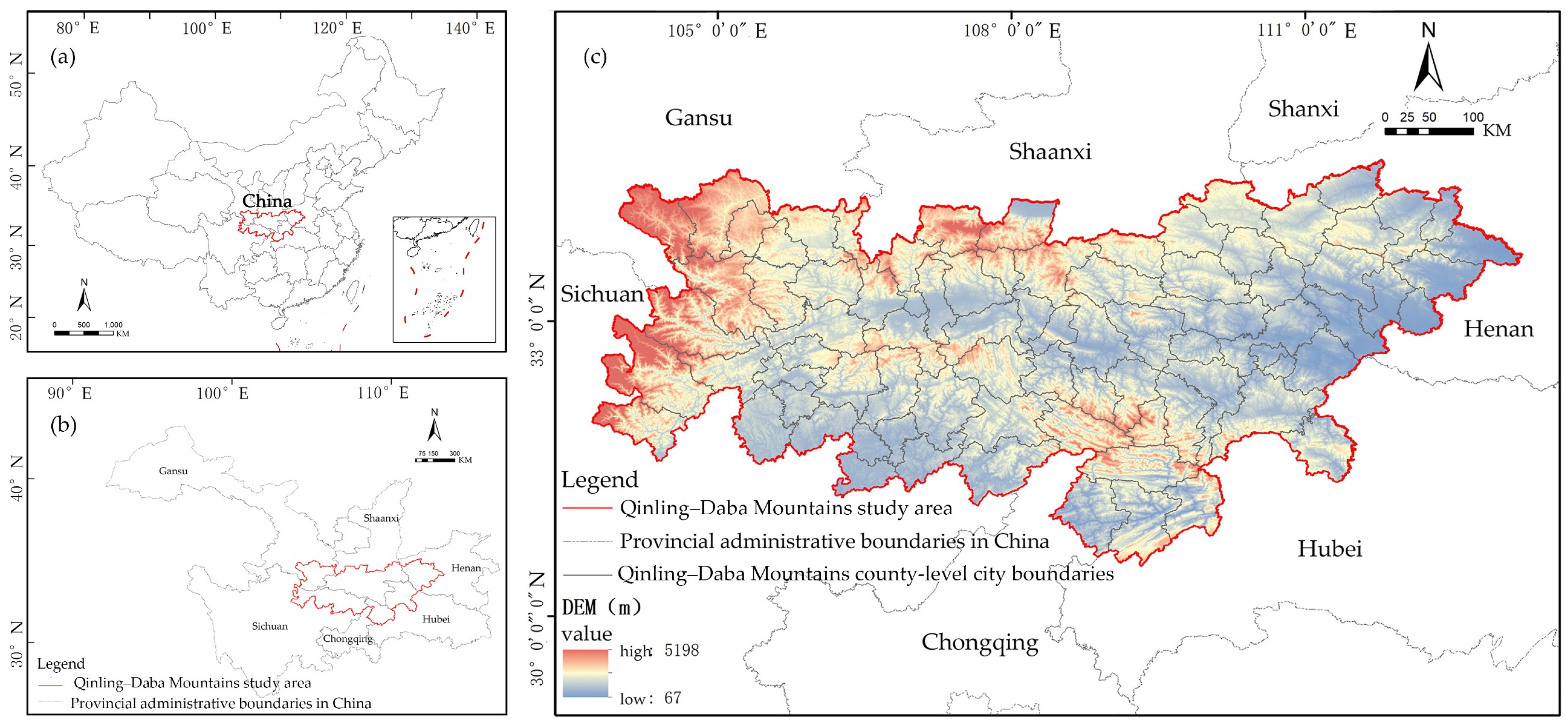
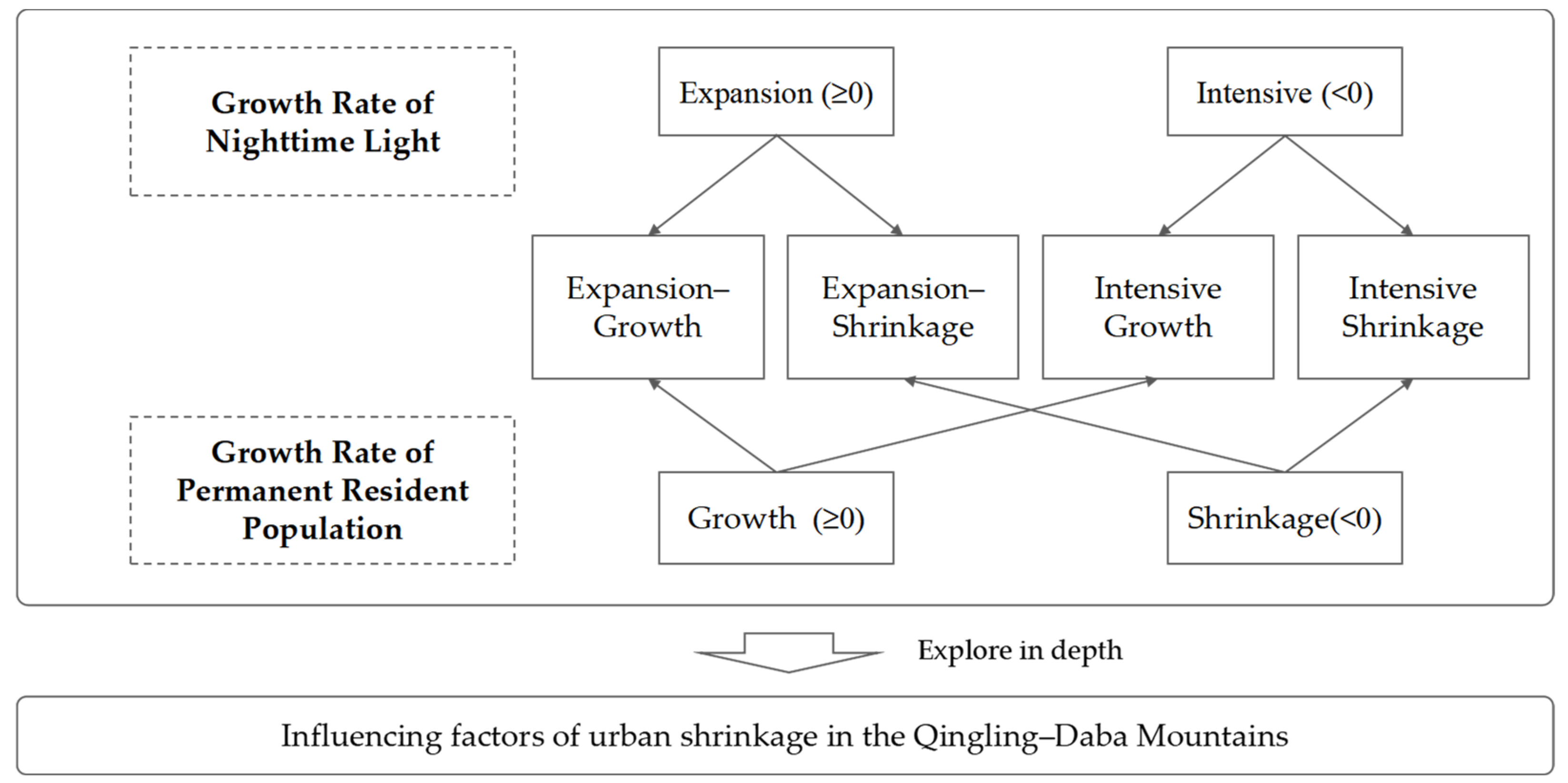
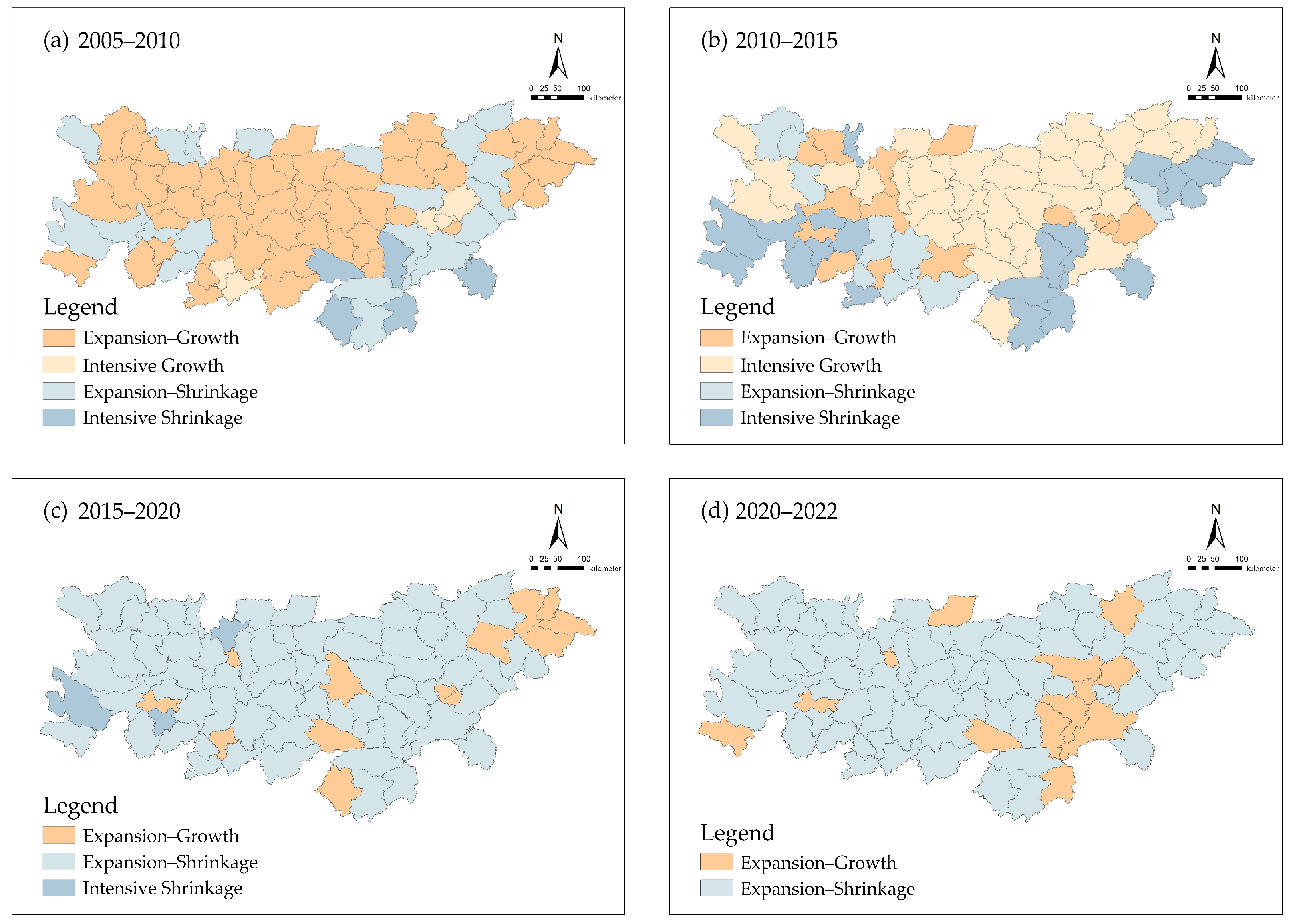
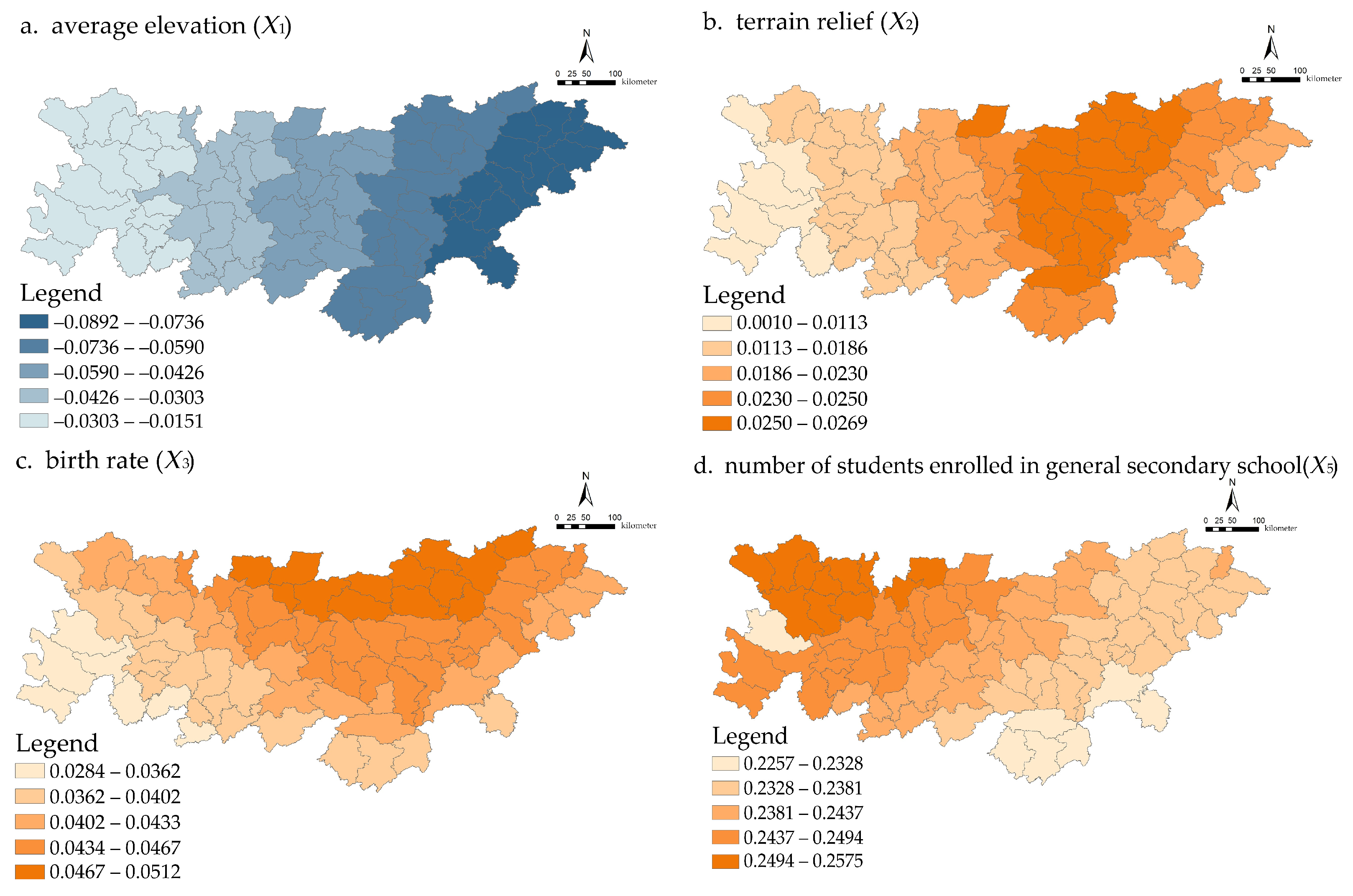
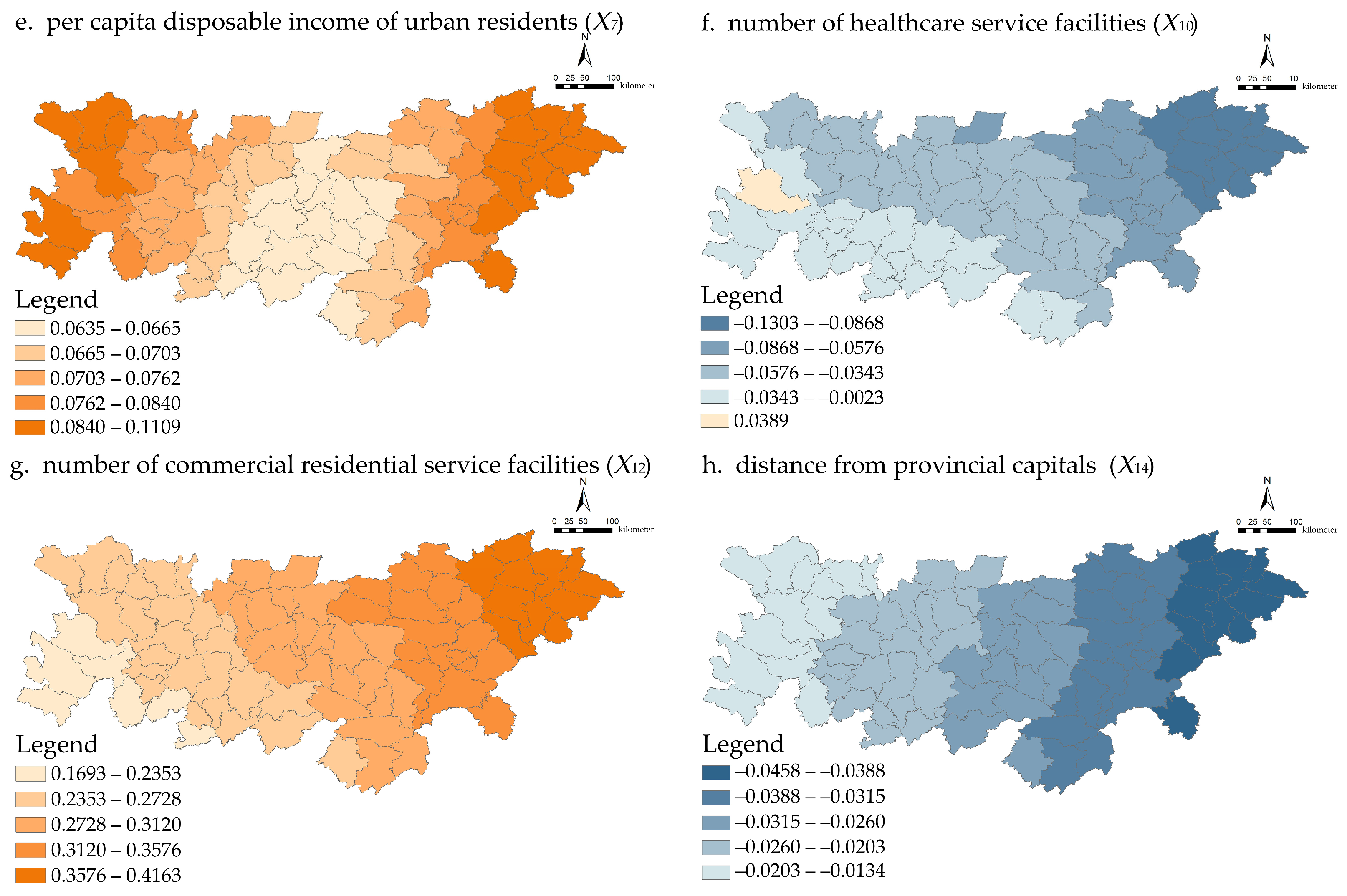
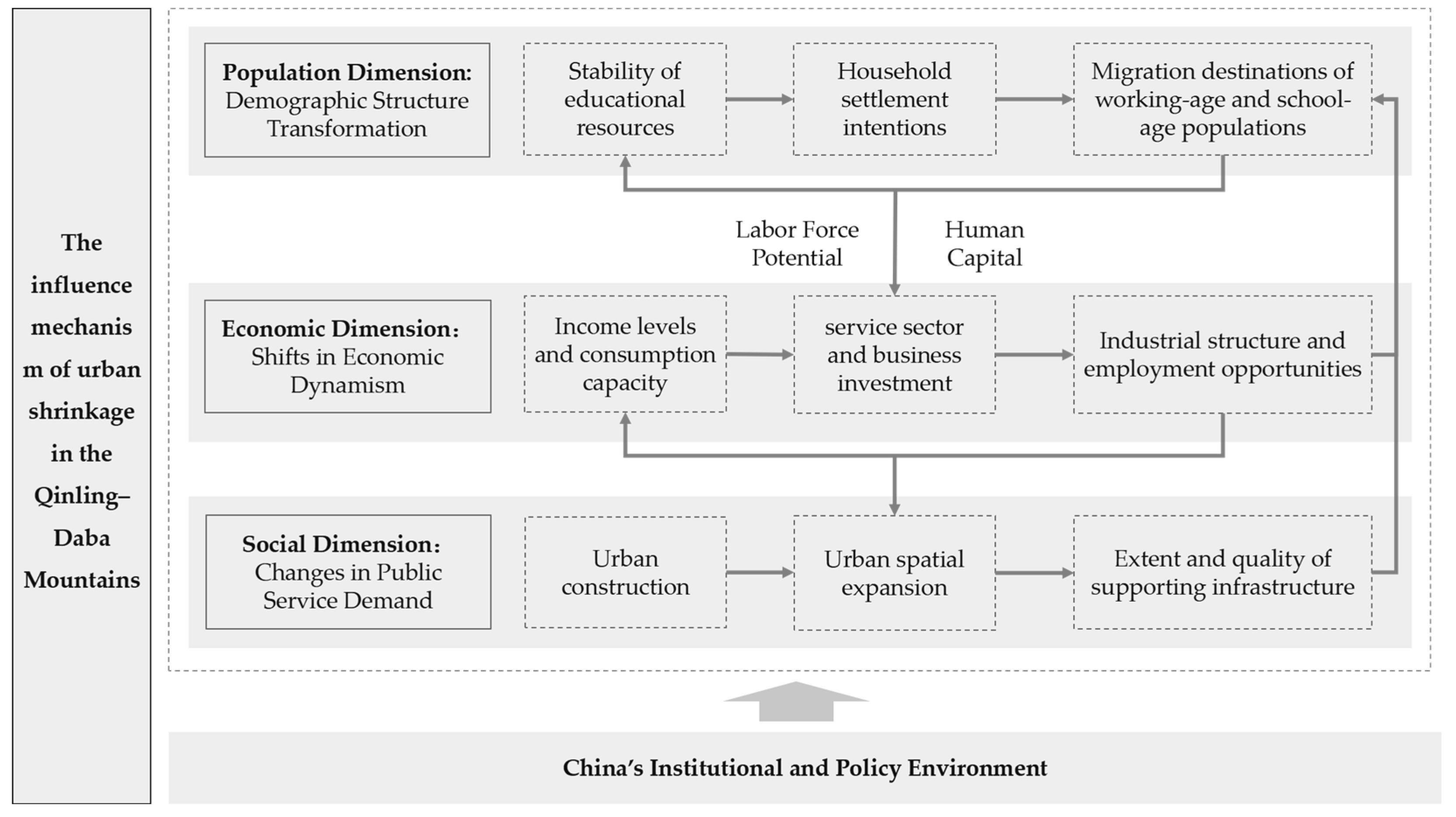
| Data Category | Data Label | Content Description | Source |
|---|---|---|---|
| Administrative Elements | Administrative Boundary Data | Geographic boundaries of county-level cities within the Qinling–Daba Mountains. | National Platform for Common GeoSpatial Information Services |
| Natural Elements | Digital Elevation Model (DEM) | Average elevation and topographic relief information. | Geospatial Data Cloud |
| Demographic Elements | Population Data | Census data encompassing permanent resident population, population structure, and migration statistics. | Provincial and Municipal Bureaus of Statistics and Official County Government Websites |
| Economic and Social Elements | Economic and Social Indicators | Economic and social development and other relevant data. | Provincial and Municipal Bureaus of Statistics and Official County Government Websites |
| Points of Interest (POIs) | Data on education, healthcare, and public services. | Amap | |
| Spatial Elements | Nighttime Lighting Data | Nighttime lighting data digital number. | DMSP-OLS and SNPP-VIIRS datasets |
| Road Traffic Data | Vector data on road infrastructure and distances from counties to provincial and prefecture-level cities. | Amap |
| Dimension | Indicator | Description of Variable | Unit | Number |
|---|---|---|---|---|
| natural | average elevation | Refers to the average difference in altitude between a given area or location and sea level. | m | X1 |
| topographic relief | Refers to a calculation of the average topographic relief for each region based on 1 km × 1 km DEM data. | m | X2 | |
| demographic | birth rate | Refers to the rate of births per 1000 population, averaged over a given period of time (usually 1 year). | ‰ | X3 |
| natural growth rate | Refers to the ratio of the natural increase in population per unit of time in a year to the average annual total. | ‰ | X4 | |
| number of students enrolled in general secondary schools | Refers to the total number of students enrolled and receiving education in general secondary schools (including junior and senior high schools). | ten thousand | X5 | |
| economic | gross regional product | Generally refers to the total market value of all final goods and services produced in a region within a year. | billion yuan | X6 |
| per capita disposable income of urban residents | Refers to the sum of final consumption expenditures and savings available to the average urban household per person over a given period of time. | yuan | X7 | |
| gross output value of industrial enterprises above designated size | Encompasses all finished industrial goods and productive labor contributions manufactured during a defined interval by industrial enterprises achieving specified annual primary revenue benchmarks. | billion yuan | X8 | |
| social | total retail sales of consumer goods | Refers to the monetary value of tangible goods sold directly by enterprises (organizations, individual businesses) to individuals and social groups for non-production and non-operational purposes, as well as the revenue obtained from providing catering services. | billion yuan | X9 |
| number of healthcare service facilities | Refers to the number of healthcare facilities according to AMap POI data. | unit | X10 | |
| number of science, education, and cultural service facilities | Refers to the number of science, education, and cultural facilities, calculated based on AMap POI data. | unit | X11 | |
| number of commercial residential service facilities | Refers to the number of commercial residential facilities, calculated based on AMap POI data. | unit | X12 | |
| spatial | total road length in a given year | Refers to the cumulative length of all roads in the study unit. | km | X13 |
| distance from provincial capitals | Refers to the road distance between the study unit and the capital city of the province to which it belongs. | km | X14 | |
| distance to municipalities | Refers to the road distance between the study unit and its corresponding prefecture-level city. | km | X15 |
| Influencing Factor | Variance Inflation Factor (VIF) | |
|---|---|---|
| natural | average elevation (X1) | 1.779 |
| topographic relief (X2) | 1.332 | |
| demographic | birth rate (X3) | 1.405 |
| number of students enrolled in general secondary schools (X5) | 2.149 | |
| economic | per capita disposable income of urban residents (X7) | 2.180 |
| social | number of healthcare service facilities (X10) | 3.896 |
| number of commercial residential service facilities (X12) | 1.038 | |
| spatial | distance from provincial capitals (X14) | 2.711 |
| Period | 2005–2010 | 2010–2015 | 2015–2020 | 2020–2022 | |||||
|---|---|---|---|---|---|---|---|---|---|
| Pattern | Number | Percentage | Number | Percentage | Number | Percentage | Number | Percentage | |
| Expansion– Growth | 52 | 64.20 | 15 | 18.52 | 13 | 16.05 | 12 | 14.81 | |
| Intensive Growth | 4 | 4.94 | 37 | 45.68 | 0 | 0.00 | 0 | 0.00 | |
| Expansion– Shrinkage | 20 | 24.69 | 9 | 11.11 | 65 | 80.25 | 69 | 85.19 | |
| Intensive Shrinkage | 5 | 6.17 | 20 | 24.69 | 3 | 3.70 | 0 | 0.00 | |
| Model | R2 | R2 Adjust | AICc |
|---|---|---|---|
| GTWR | 0.9073 | 0.9055 | −376.93 |
| Influencing Factor | Minimum | First Quartile | Third Quartile | Maximum | Mean | Significance Percentage (%) | |
|---|---|---|---|---|---|---|---|
| natural | X1 | −0.1540 | −0.1072 | 0.0128 | 0.0605 | −0.0502 | 82.96 |
| X2 | −0.0332 | −0.0097 | 0.0477 | 0.0649 | 0.0207 | 70.86 | |
| demographic | X3 | −0.0934 | −0.0308 | 0.0995 | 0.2109 | 0.0427 | 88.64 |
| X5 | 0.1484 | 0.1909 | 0.2611 | 0.4248 | 0.2417 | 100 | |
| economic | X7 | −0.3903 | 0.0603 | 0.1646 | 0.4035 | 0.0763 | 99.75 |
| social | X10 | −0.4303 | −0.1786 | 0.0657 | 0.1482 | 0.0506 | 86.17 |
| X12 | −0.0097 | 0.0587 | 0.5490 | 0.9245 | 0.2964 | 97.78 | |
| spatial | X14 | −0.0836 | −0.0345 | −0.0182 | 0.0151 | −0.0282 | 81.98 |
| Influencing Factor | 2005 | 2010 | 2015 | 2020 | 2022 | |
|---|---|---|---|---|---|---|
| natural | X1 | −0.1219 | −0.0921 | −0.0691 | 0.0087 | 0.0206 |
| X2 | 0.0536 | 0.0413 | 0.0300 | −0.0071 | −0.0141 | |
| demographic | X3 | 0.1254 | 0.1102 | 0.0496 | −0.0474 | −0.0242 |
| X5 | 0.2070 | 0.2562 | 0.2081 | 0.1646 | 0.3728 | |
| economic | X7 | 0.2439 | 0.1671 | −0.2140 | 0.1136 | 0.0710 |
| social | X10 | −0.1575 | −0.2687 | 0.1073 | 0.0361 | 0.0318 |
| X12 | 0.5460 | 0.6944 | 0.1447 | 0.0526 | 0.0444 | |
| spatial | X14 | −0.0492 | −0.0362 | −0.0231 | −0.0235 | −0.0093 |
Disclaimer/Publisher’s Note: The statements, opinions and data contained in all publications are solely those of the individual author(s) and contributor(s) and not of MDPI and/or the editor(s). MDPI and/or the editor(s) disclaim responsibility for any injury to people or property resulting from any ideas, methods, instructions or products referred to in the content. |
© 2025 by the authors. Licensee MDPI, Basel, Switzerland. This article is an open access article distributed under the terms and conditions of the Creative Commons Attribution (CC BY) license (https://creativecommons.org/licenses/by/4.0/).
Share and Cite
Lv, Y.; Yang, S.; Zhao, D.; He, Y.; Li, S. Urban Shrinkage in the Qinling–Daba Mountains: Spatiotemporal Patterns and Influencing Factors. Sustainability 2025, 17, 7084. https://doi.org/10.3390/su17157084
Lv Y, Yang S, Zhao D, He Y, Li S. Urban Shrinkage in the Qinling–Daba Mountains: Spatiotemporal Patterns and Influencing Factors. Sustainability. 2025; 17(15):7084. https://doi.org/10.3390/su17157084
Chicago/Turabian StyleLv, Yuan, Shanni Yang, Dan Zhao, Yilin He, and Shuaibin Li. 2025. "Urban Shrinkage in the Qinling–Daba Mountains: Spatiotemporal Patterns and Influencing Factors" Sustainability 17, no. 15: 7084. https://doi.org/10.3390/su17157084
APA StyleLv, Y., Yang, S., Zhao, D., He, Y., & Li, S. (2025). Urban Shrinkage in the Qinling–Daba Mountains: Spatiotemporal Patterns and Influencing Factors. Sustainability, 17(15), 7084. https://doi.org/10.3390/su17157084








